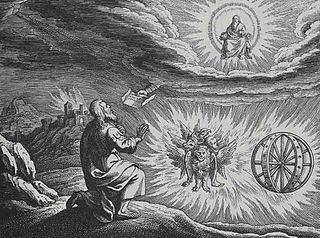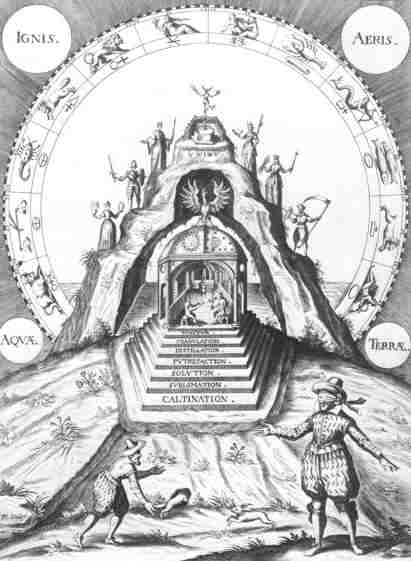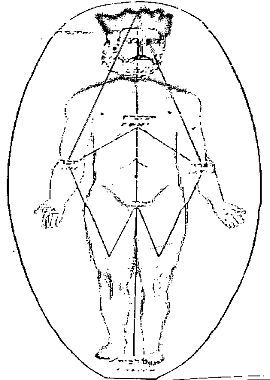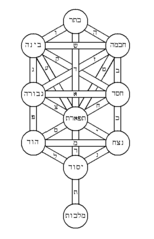The Kabbalah
The Kabbala was the unofficial jewish mystics. The movement consisted of single rabbis and smalll groups of disciples, who presented interpretations of parts of the jewish bible. These kabbalists looked at the bible from an esoteric standpoint and searched for the hidden allegories. Eventually some of them had contacts with the higher spiritual hierarchies of the past.
The Sohar is the most important multi-volume work of the Kabbalah. The name Sohar means 'Splendor', and the book is traced back to the texts of the prophets Ezekiel (Ez 1,28: 8,2) and Daniel (Dan 2,31; 12,3).
Later kabbalists develeoped further theories about the Ain-Soph and the en-soph-aur, the infinite divine light, the 10 sephiroth and Adam Kadmon as symbol of the selfrealized man.
Merkabah Mystics
The Merkabah('Wagen') or Merkavah - mysticism (100 BCE – 1000 CE) was a precabbalist scool which relied on the visions of the Ezekiel Chap. 1, which hase similarities to the tarotcard 10. 
They concentrated on the Heichalot - Literature with the divine palaces, the throne of god, the seven heavens and names of god as a means für the ascend into the heavens. All this had long ago been mentioned in Henochbook 2.
This Heichalot (Hekhalot : heavenly places) - literature contains several bigger texts like
- Hekhalot Rabbati ( The Greater Palaces, or Pirkei Hekhalot) - the ascend of Rabbi Ishmael
- Hekhalot Zutartey ( The Lesser Palaces ) - the ascend of Rabbi Akiva
- Maaseh Merkabah ( Work of the Chariot ) - Collection of hymns and names of god
- Merkavah Rabba ( The big Chariot )
- Sepher Hekaloth ( Enoch 3 ) - Book of the Palaces
- Re'uyyot Yehezqel (Visions of Ezekiel)
- Massekhet Hekhalot ( The Tractate of the Palaces )
- Shi'ur Qomah ( Divine Dimensions )
- Sepher Ha-Razim ( Book of the Mysteries ) - seven heavens. Names of 700 angels
- Harba de Moshe ( The sword of Moses )
- Alphabet of Akiba ben Joseph
and further smaller texts. Most of these books were written between 200 and 700 CE. Also the christian Neoplatonist Dyonisius wrote in his books about divine names and the celestial hierarchy. Another gnostic scripture with ascends is the 'Pistis sopia' from the Codex Askewianus.
Kabbalah
Features of the modern Kabbalah are the kabbalistic tree with the 10 Sephiroth, the EN-SOPH-AUR (infinite light) and the En-Soph as symbol of the divine, with which an adept cannot unite. Books as the "Sepher Jezirah" speaks about "Jah Jahve Sebaoth", the ONE almighty, merciful and gracious God and creator (comparable to the Ishvara ).
EN-SOPH-AUR (infinite light) and the En-Soph as symbol of the divine, with which an adept cannot unite. Books as the "Sepher Jezirah" speaks about "Jah Jahve Sebaoth", the ONE almighty, merciful and gracious God and creator (comparable to the Ishvara ).
In addition, there are a number of writings of partly opposing Kabbalistic currents as the ecstatic and the theosophical direction of the older Kabbalah.
Since Pico della Mirandola (15th century), a Christian Kabbalah (Cabala) and a Hermetic Kabbalah (Qabalah) have developed alongside.
Image > : Christian cabala : 'Alchemical' steps to the highest sanctuary(18)
The 22 Tarotcards, the small Arcans, which have references to these letters, are however already a mapping of the process of the 22 universal steps on a spiritual system. On step of 16 the universal doctrine (see the accompanying Tarotcard 16), this divine power overtakes the leadership of the process: God extasy, like the Ishvara Samadhi of the Raja - Yoga.

In the end, the Kabbalist realizes all Sephiroth in himself and becomes a personification of "Adam Kadmon", the manifestation of the Sephirotic tree.
Beneath the Sohar exist other important kabbalist books like the
- Sepher Ha-Bahir
- Sepher Jezirah, the book of creation (Jah Jahve Sebaoth : Jesaja 6.3) with the letters of the alphabeth and the protecting name of god
- Pardes Rimonim
- Clavicula Salomonis
- Sepher Raziel HaMalach(Book of the angel Raziel) with magical sygils.
- 'Reschit Chochma'

There are further books from contrasting kabbalistic currents such as the ecstatic and theosophical orientations of the older Kabbalah. Since Pico della Mirandola (15. Jh.) developed a christian Kabbala(Cabala) and a hermetic Kabbala(Qabalah).
The Sohar recognizes four (72) stages for the biblical exegesis:
- The literal text ( hebr. pschat )
- die allegoric meaning (allegory, hebr. remez)
- the meaning in life (exegesis, interpretation, hebr. drasch)
- the mystic meaning (secret, hebr. sod)
 The goal of the Kabbalists war the selfrealisation of Adam Kadmon, the divine sephirotic man described by the Sepher Ha-Bahir. In addition to a pure life-style, the main means for this was the- mysticism of the alphabet and of the divine names.
The goal of the Kabbalists war the selfrealisation of Adam Kadmon, the divine sephirotic man described by the Sepher Ha-Bahir. In addition to a pure life-style, the main means for this was the- mysticism of the alphabet and of the divine names.
The kabbala teaches that it is not possible to unite with the EN-Soph and so goes up to step 18 of the Universal Path.
The ecstatic Kabbalah
== Sepher Jesirah ==
A short extract from the Sepher Jesirah of Lazarus Goldschmidt, Frankfurt - Main, Kauffmann, 1894 - ( Nachdruck bei der Wissenschaftlichen Buchgesellschaft Darmstadt, 1969)
Chapter I
In thirty-two hidden pathes of wisdom, Jah Jahve sebaoth, the God of Israel, the living God and King of the world, the Almighty, Merciful, and Gracious God ... He created his world by three counter - principles: number, counters, and counted.
Chapter II
Ten numbers without something, and twenty-two basic letters, three mothers, seven double, and three simple.
... III : 22 letters arranged in a wall in a circle :....
... There is nothing in the good about 'ONG' and nothing in evil about 'NGA'
... Ten numbers without anything, their appearance is like the appearance of a lightning, their goal is endless, his word is in them In back and forth...
Chapter IV
7. Moreover, God has made the one against the other, the good against evil and the evil against good, good from good and evil from evil. Good distinguishes evil, and evil distinguishes good. Good is kept for the good and evil for the wicked.
Chapter IX
Ten numbers without anything. Their measure is ten, but they are limitless. There is a dimension of the beginning and the end, a dimension of good and a dimension of evil,....
Ten numbers without anything. Their appearance is like a flash. Their goal is endless. HIS word is in them in the back and forth
ONE - the divine spirit. His throne has always been ready. His name, which continues to live in eternity, is eternal and everlasting.
Voice, spirit and word, that is the spirit of the holyest. His beginning has no beginning and his end has no limit.
Chapter XIII
He chose three letters from the simple (the mystery of the three mothers A-M-Sch) and put them inro his great name and sealed with them the six ends.
Five, he sealed the height, turned upwards and sealed it with J.H.V .... etc.
* Archive.org : The complete text of the " Sepher Jezirah " (Westcott Rittangel 1893)
* Comment : The 22 letters of the Thora have been added to 22 steps of consiousness of the 22 tarotcards.
The name of God, often according to Ex 3.14 EU (אֶהְיֶה אֲשֶר אֶהְיֶה ehyeh ăšer ehyeh) translated as "I am who I will be", according to the Septuagint "I am the one" (ἐγώ εἰμι ὁ ὤν egô eimi ho ôn), was used with great reverence by the Israelites.
The Schem ham-meforasch (tetragrammaton), which is comparable to the Nada or Shabda, is the divine synthesis of all vibrations and can only be experienced. Creation can be expressed by certain vibrations. Combinations of letters like "ONG - NGA" stand for the good and the evil. There are others and similar vibrations and also other names of god. All that is the secret science of Quabbalah.
The cabbala teaches 10 Sephiroth('cernels of the good') and several Qlippoth(shells), in which the evil resides. The equivalent of the latter are the shells of kashmir shaivism.
The appearance of the 10 Sephiroth is like a "flash without end", says the Sepher Jezirah. A similar flash appears in the Tarotcard 16. In the end the kabbalist realizes all Sephiroths in himself and becomes a personification of "Adam Kadmon".
Hinduism and quabbala
The Schem (Tetragrammaton) is comparable with the greece Logos and the hinduist Shabda of the Ishvara -Tattwa (Omkara, Nada). Ishvara is the rather equivalent to Jah Jahve Zebaoth.
On the buddhic plane is another impure pranava which is a vibration of the maya - ethers, which are the basis of the Qlippoth.
In the Mahabharata is a "Nâga" a snake oder a negative underworldly force, whose allegorical arch-enemy is the eagle Garuda, often depicted with serpents in his claws.
The Sepher Jetzira comments the letters of the alphabet. It says in chapter 7 'There is nothing in the good about 'ONG' and nothing in evil about 'NGA'.'
Mantras with the mit der ending "NGA" are not used in india.
Hrim und Hring are traditional Mantrams to control the Maya. The syllable "Ong" is not only used within 'Ong namo' but also in 'Hong-se', die spiritual swan.
Hiram(Hjrm) is the salomonian master-architect. The indish "Sunprayer"(Surya Namaskar) uses similar Mantras like Hrim, Hraum, Hrum und Hraim. These have effects on the lower planes.
The order of the letters is also important. The Sepher Jezirah discusses accordingly all combinations of JHV to VHJ.
Such linguistic considerations can only be applied on the ancient Hebrew language as well as on the ancient Sanskrit.
God created the worlds according to the Kabbalah by three counting principles. All science, therefore, ends at a certain limit where there are no more units. There is a world no longer comprehensible to reason, since it has no measure for the infinite and the unity. Among these are the mathematically comprehensible natural laws, which go beyond the well-known mathematics. The present man has not the intuitive intellect to describe the upper worlds mathematically, which he does not even know and therefore can not model - but he would gladly conquer them - not for his sake.
The Sepher Jezirah speaks of a graceful and merciful God "Jah Jahwe Zebaoth". The John Apocalypse describes god different: "No man could stand before the wrath of the Lamb, and of the one who sat upon the throne."
The divine creates the power of anger (or the Hindu Maya force), and the evil ("nga") was thereby created.
The Old Testament also states: "Fear the Lord, for he is great and mighty." In the Kabbalist writings, only Quodesh, the saint, is described as a kind and gracious ruler.
Therefore "Jah Jahwe Zebaoth" is comparable to the creator god of the sixth plane (like ishvara) and not the mostly unknown highest godhead above the hindu parabraman or satyaloka.
Literature
In addition to the "Sohar" with the Idra Sutta and the Idra Rabba the kabbalah includes newer books of Eliphas Levi wie "Transzendental Magic" and of Knorr von Rosenroth (Kabbalah Denudata), and not least of all recently the invaluable book by Franz Bardon: "The key to the true Quabbalah".
- Texts of the Golden Dawn about Kabbala
- Sword of Moses (Harba de Moshe)
- Sepher Jezirah : Goldschmidt(Frankfurt 1894).
- A wiki about the Sohar
- Scholem : Das Buch der Schöpfung (Studia Judaica III : Ursprung und Anfänge der Kabbala; Belima etc. )
- A wiki about the Tetragrammaton
- An Article about the 'Ejn Sof Or'
- Kabbalah Unveiled (Mathers)
- Wiki about Adam Kamon
- Inner.org : Kabbala
- The Kabbalah - its doctrines , development and literature by Ginsburg, Christian D. (Christian David), 1831-1914
- A farewell to the Merkavah tradition Andrei A. Orlov
- Jewish Mystizism - Kabbala, J. Abelson
- {1] The Beginning of Wisdom, A Compendium of Primary Kabbalistic Principles, engl. Translation of Reschit Chochma by Rabbi Amiram Markel& Michoel Tzvi Wolkenfeld
- Early jewish literature
- Surya Namaskar : 10 point way to health PDF
- Kabbalist books
- Seven days of creation
of Spirituality
universal-path.org